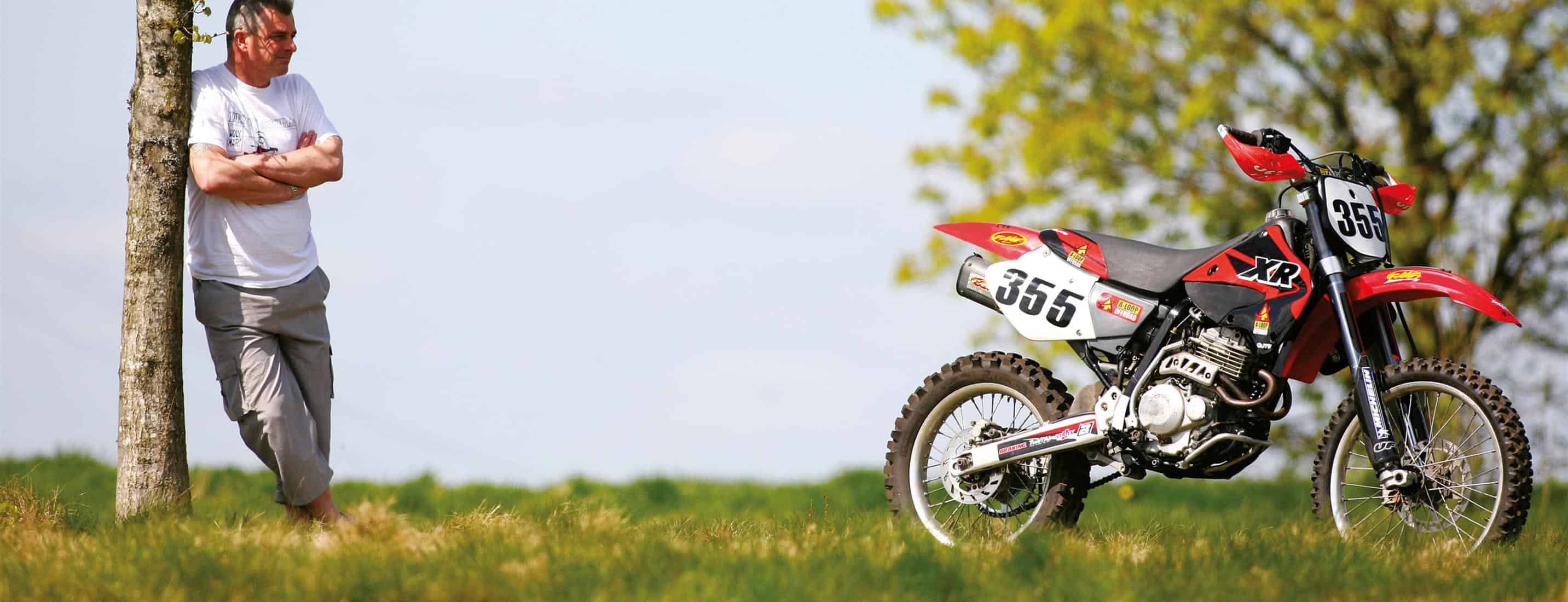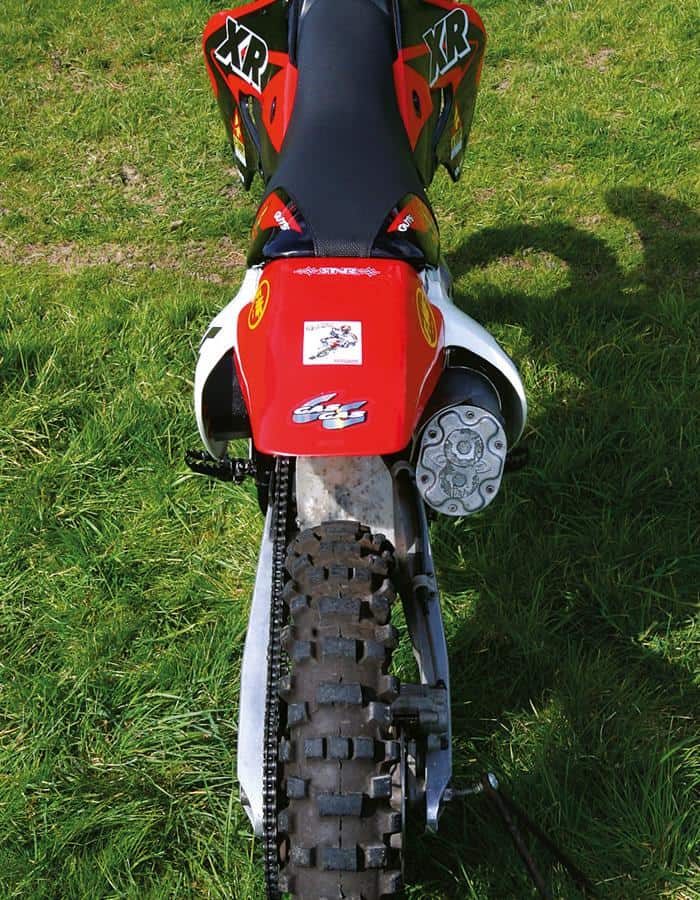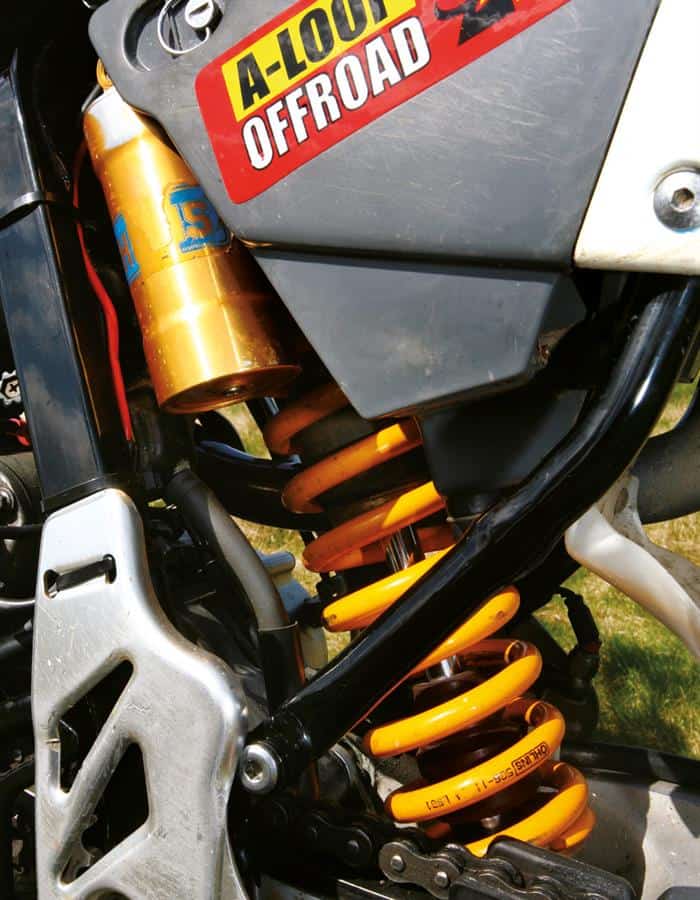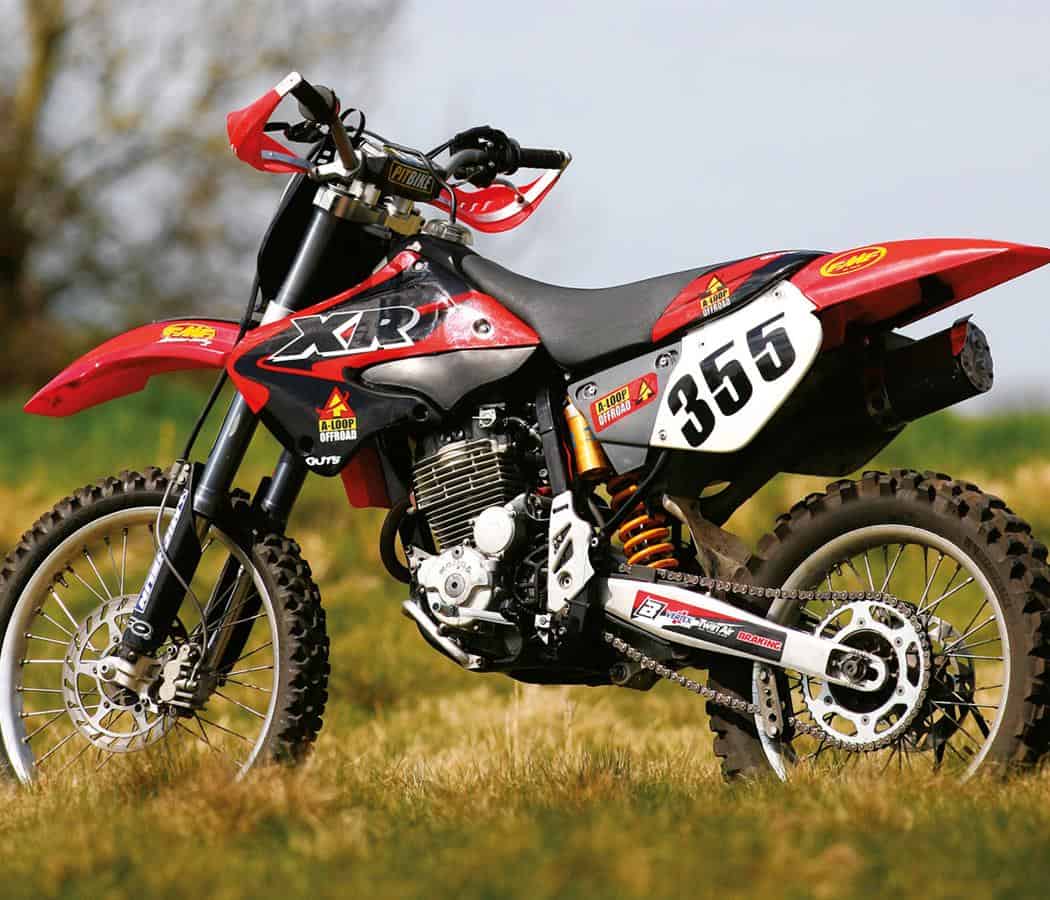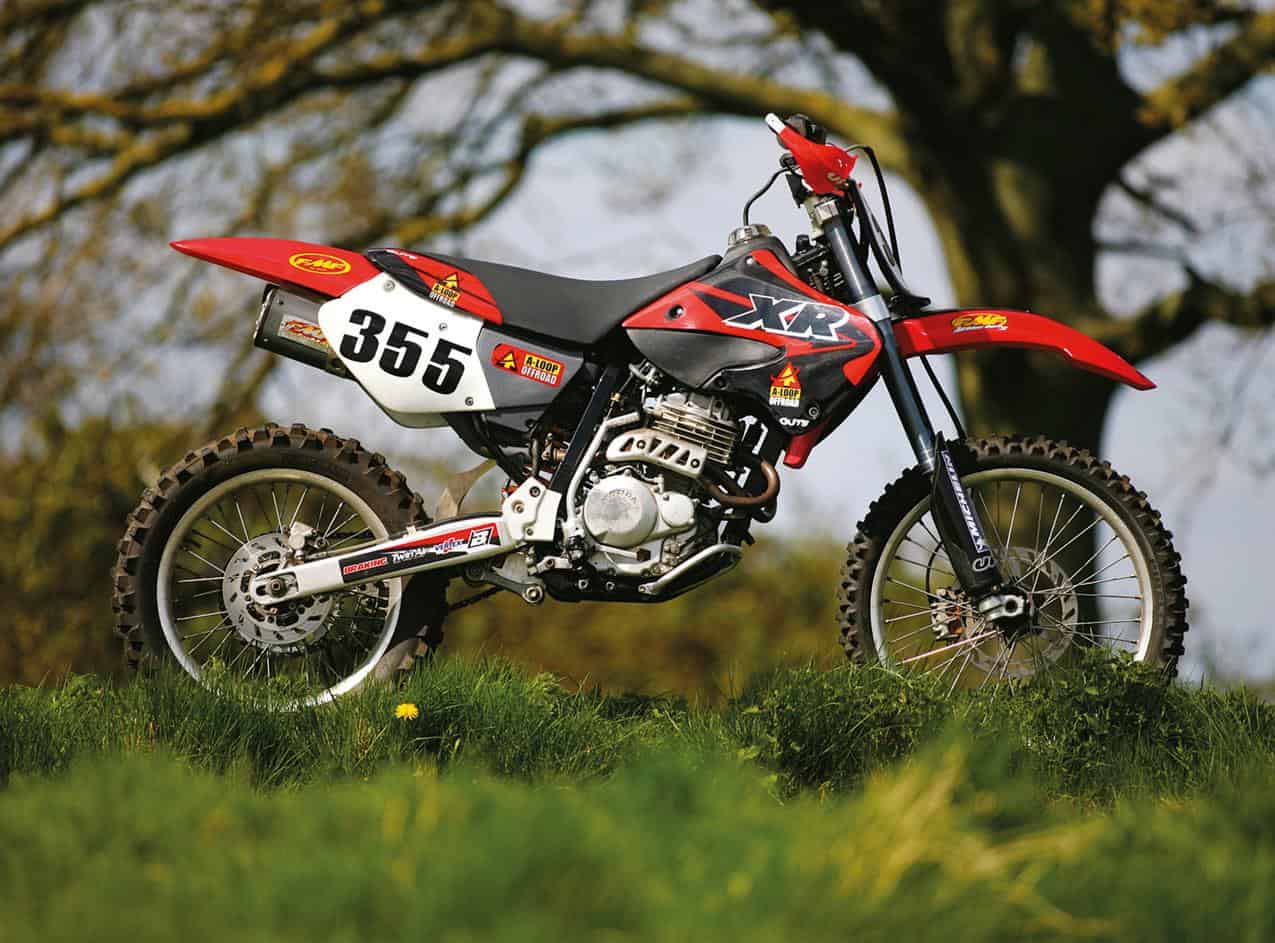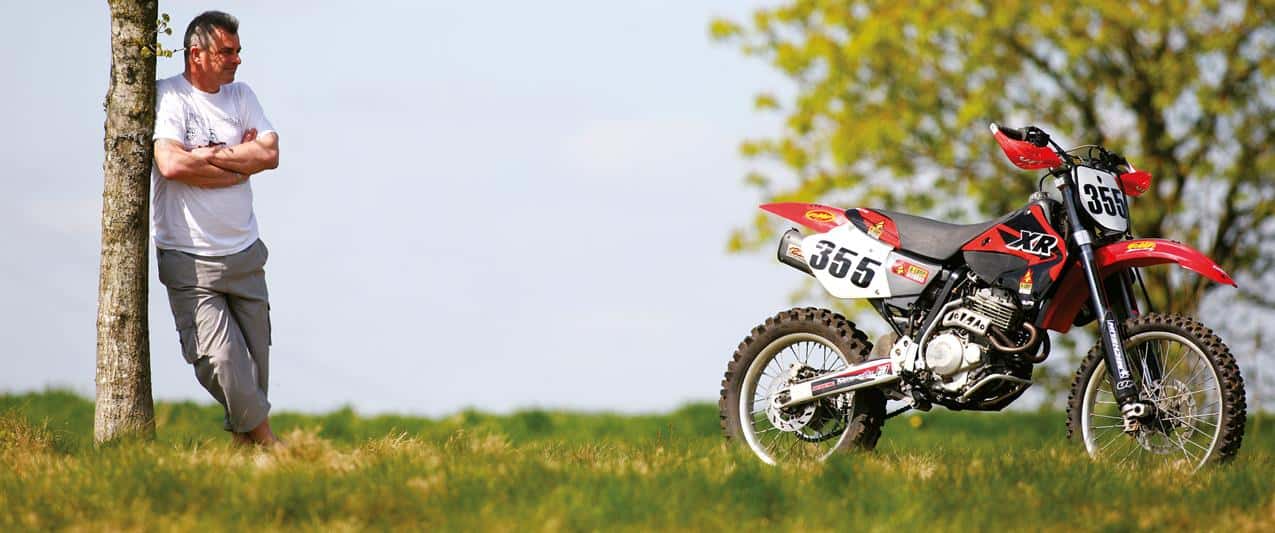If no-one sells the bike you want, or you can’t afford to buy one new, then building your own makes perfect sense. So Ian Davis did just that…
It was mid-morning and we were just polishing off our second round of super-strong coffees and partway through the daily trawl through spam emails when the phone rang. The exact details of the conversation escape me, but it went something like this:
‘RUST, good morning’, I answered in my usual chipper manner.
‘Hello, it’s Ian Davis here’, said the voice with a slight West Country lilt, before immediately getting to the point of the call. ‘What do you think would happen if I added two inches to the wheelbase of my XR250?’
At this point there was a slight pause in proceedings as I put him on hold, and announced to the office what I’d just been asked.
‘Two inches longer? What’s he doing, building a hillclimber?’ Came the retort. ‘Tell him he’ll need something more pokey than an XR250…’
So I dispensed some sage advice (plus a little more Mickey taking, no doubt) and forgot all about the phonecall until a few weeks later when Ian called again. As it turned out he wasn’t building some kind of crazy cliff-scaling machine – not that we REALLY thought he was, you understand. Instead the 50mm increase in wheelbase was due to the fitment of some ‘proper’ suspension units. But this wasn’t simply a case of bolting on some upgraded forks and shock, as Ian was building something a little different to suit his needs. And to explain what they are we need to travel back to 2001, and Weston Beach Race…
Seize the Day
Having returned from working in the Middle East with his much-loved Gas Gas MC250 (no that’s not a typo, he owns an ultra-rare Spanish MX bike) Ian seized the thing solid on the sands of Weston-Super-Mare. Forced to push the bike across the line in order to place as a finisher he decided there and then that an air-cooled four-stroke would be the bike to have. So, after a five-year hiatus to build a house and settle back in Blighty, he set about finding a suitable mount…
Obviously a big ol’ XR600 or the like wasn’t going to be much fun for the hare ‘n’ hounds races he enters and, wanting something manageable in snotty conditions, he decided that 250cc was the capacity to have. But which twofifty? After reading-up on the available machines Ian opted for an XR for no other reason than they run a simple and easy to adjust rocker arm top-end.
Whilst you CAN, of course, race a standard XR250 it’s really not a great competition tool. Obviously he knew that he was going to be (well) down on power compared to most MX and enduro tackle, but it was the XR’s chassis that Ian saw as the biggest stumbling block. Basic suspension and ancient ergos didn’t really suit the intended purpose. So the plan was to slot an XR lump into a higher specced, racier, frame.
Although the CR500 isn’t exactly a modern chassis design Ian figured that it would be far better than the XR’s and certainly big enough to accept the four-stroke motor. So when a CR rolling chassis appeared on eBay he snapped it up, along with what he thought was an XR engine. ‘It turned out to be an XL,’ Ian recounted, ‘and it didn’t have the swingarm pivot running through the back of the motor. So I sold that and the CR… but I made money on them!’ Back to square one.
Basque in the Glory
Some time later Ian was browsing the internet auctions when he came across a 2004 Japanese import XR250. Far from simply being a home-market version of the Honda we got here in the UK, the Japanese bike came with USD forks (though sadly little adjustability), CRF-a-like styling and most importantly electric start. That was it, Ian was smitten. ‘I was raving about this bike to the wife, but all she could say was “it’s a bike”. Little did I know that all the time she was looking over my shoulder clocking the eBay number!’
A short time later Ian’s birthday rolled around and he came home from work to something of a surprise. ‘I backed the car up the driveway and my mobile rang. It was my wife. “Don’t go into the house”, she said. “Hit the remote on the garage door.” Up went the door and there she was sat on that very same XR wearing stockings, suspenders and a basque. “Which do you want?” she asked, “me or the bike?” Now, when I tell the story, I say to everyone that I replied, “I’ll have the bike – it’s slimmer and better looking”!’
We’ve never met Ian’s wife, and we don’t want to get ourselves in trouble here, but the XR IS a particularly fine example..! We know this because it’s remained in bog stock trim and lives under a dust-sheet alongside the old, and now rebuilt, MC250, and a 2009 EC200. ‘I didn’t want to race it or cut it up. It’s too nice. But I knew it was what I wanted,’ explained Ian. And so the search for a donor bike continued…
Eventually another XR was found – a 1996 XR250 Baja with that important electric start. Ian only knows exactly what model the bike is because his local Honda dealer checked the frame and engine numbers. ‘It was a field bike’, he explained, ‘a real shed. The bloke was selling it because it was seized and I got it for £192. I took the generator cover off, tried to turn the motor over and heard this click. It turned out that only the starter motor was seized so I stripped and rebuilt that. Then it started okay.’
Being a field bike the previous owner had little need for lights and indicators so had butchered the wiring and taped up the resultant mess in miles of insulating tape. Ian set about thinning out the loom, without the help of a wiring diagram. Having cut through the coagulated tape-glue and pared back any excess sheathing he disconnected one wire at a time, kickstarting the bike each time to ensure that it still ran, until he was left with the bare minimum of wiring. ‘Then, once I got the engine sorted, I set out to get a chassis for it…’
Having placed an ad in the classifieds, Ian was contacted by a bloke who had a 2003 Gas Gas EC400FSE for sale. The motor had grenaded and if Ian handed over £600 then the chassis was his. ‘It was absolutely everything except the engine’, smiled Ian.
Hammer Time
XR owners probably won’t be surprised to hear that removing the Honda’s engine turned into something of an ordeal. Having the swingarm pivot seize into the back of the engine is a known fault on these machines and on an old field bike it was a given. A good ‘thwack’ with a hammer did absolutely nothing and Ian was forced to brace the frame with wood and attack it with oxy-acetylene and a lump hammer before the bike relinquished its corrosive grip on the swingarm spindle.
With both bikes stripped down to their bare frames Ian offered up the Honda engine only to find that the Gas Gas frame wasn’t quite as accommodating as he’d hoped. ‘The exhaust fouled the front downtube,’ he highlighted, ‘but the biggest problem was that there wasn’t room for the carb.’ Being a steel frame there was potential to chop and re-weld the frame, and have new headers made to suit, but Ian didn’t really want to go to such lengths. So he struck upon the idea of fitting the Gas Gas suspension to the Honda. ‘And I knew that I could get a Aloop bits to give enduro ergos’, he added. The American company produce kits for XRs which give a flatter seat and tank, and (faux) radshrouds to enhance the styling with some late ‘90s CR chic. Long before Ian sorted the bodywork, though, he had the small matter of getting the Gas Gas parts to mate with the Honda frame to attend to.
‘I took the headstock bearings along to a bearing shop and asked for something with this internal diameter and that external diameter’, Ian explained. ‘The old bloke behind the counter got out his verniers, measured the bearings, and found exactly what I needed. I’ve kept the packet so that I know what it is should I ever need replacements.’ The triple clamps required a little bit of packing in order to get everything lined up at the right height but with the new bearings in place the Gas Gas front-end essentially fitted straight on. And when I say ‘front-end’ that’s everything including the forks, bars, brake system and wheel – the whole shebang! Unfortunately the back-end wasn’t quite so simple…
Fit and Finish
A pair of 6mm spacers were all that was required to ensure the Gas Gas swingarm fitted through the back of the XR motor and that is where the ‘bolt-on’ ended and the ‘measure-cut-weld-repeat’ began.
The frame, engine and swingarm were taken to a local welding firm who chopped off the linkage brackets, waited while Ian assembled the components, tack welded the brackets back on, again waited while Ian stripped out the engine and suspension again, and then finally seam welded the bracketry in place!
Sadly, the swingarm was held too high so Ian ground down the linkage plate in order to get everything to work together. This didn’t really help so a new linkage plate was required.
Using measurements taken from his other Gas Gas, plus comparing the way the swingarm sat in both the 400 Gasser and Honda frames side-by-side on his workbench, Ian produced a number of wooden linkage plate mock-ups. ‘Being an old engineer’, he explained, ‘I made a proper drawing and took it to the fabricators.’ The resultant plate cost him £200 but at least the back-end was now riding at the desired height.
As with the rear suspension, the Aloop tank, seat and bodywork weren’t a straightforward fit. The kit is designed for a US/UK spec XR and under the skin they’re slightly different from the Japanese-market machines, with various brackets and plates in different places. ‘The rear seat mounts are the same on all of the 250s,’ explained Ian, ‘so I started at the back and worked forward.’ Various brackets and lugs had to be chopped off and welded back on to allow for the US parts, and Ian has nothing but praise for the welder who did the work. ‘He was so patient’, Ian explained. ‘Most people would’ve told you where to go but I was there, constantly fitting and refitting the parts as we added more brackets and lugs. The welding is second to none and he only charged me 40 quid, including the work done for the linkage.’
Once the welding was completed Ian had the frame powder-coated gloss black and then began the assembly process. While the standard XR tank is a bulbous part which sits above the frame and then extends down each side of the spine, the Aloop is essentially two halves which slip down either side of the central frame rail. Only on Ian’s bike it was a reluctant fit. To remedy the problem he simply boiled-up a few kettles of water, tipped them into the tank, and shoved it into place. Leaving the softened plastic to cool for a day, when he went back to the bike the tank fitted perfectly and it now slips on and off a treat.
The Gas Gas’ rear master cylinder was mounted on the frame and the Honda lever adapted to fit. Why not just mate the Honda pump to the Gasser’s caliper? Well Ian was concerned that although both marques used the same brand of brakes the master cylinders may run different bore sizes. And so to ensure that the Gas Gas brake worked as intended he used the bike’s master cylinder. Makes sense, really.
Over the winter Ian stripped and rebuilt the engine, giving it a little more pep along the way. The piston is a Wiseco hi-comp part and the ports and head have been polished. The valves were reground, a new clutch fitted, and an eBay-purchased FMF can slipped onto the stock headers. There’s a little more ‘burble’ than stock, but it’s still as quiet as a modern day enduro machine.
Firing the freshly fettled lump into life, the starter button switchgear is ‘something that was laying around in the garage’ and Ian’s fitted it (upside-down) on the left-hand-side of the braceless bars. Why? ‘There’s no room on the right,’ he explained, motioning towards the throttle housing and brake master cylinder assembly. ‘I’ve left the switches on the brakes so that should someone want to put it on the road they can.’ Indeed, Ian’s left enough of the wiring in place to hook up the necessary lights and switches should the need arise.
The Long and the Short of it
Ian has no real intention to make the bike road legal just yet though – he’s got the other XR for road and occasional green lane use. Instead the Honda is intended as a racer for when the tracks are really snotty. But surely his EC200 is perfect for that? ‘I really like the 200 in the dry but I wanted something that’d really chug through winter mud and find traction on the climbs. This will haul me up slippery hills where the 200 just spins.’ And without radiators to tweak or boil over the little 250 is pretty indestructible to boot.
With the longer forks and a lengthier swingarm the wheelbase has actually stretched 45mm over stock, but at 1465mm it’s still short for an enduro bike. The seat sits pretty high, but it’s by no means towering. ‘I think I got the linkage wrong’, exclaimed Ian when I first stepped into his garage, ‘it’s way too soft.’ So there’s a little work left to do in order to get it set-up for racing, but with any luck it won’t be too long before the bike’s being used in anger.
All-in the ‘Gassonda’, as his mates call it, cost Ian roughly £2200 but by selling off various parts it only owes him £1800. ‘If I sell all of the unused bits, then it’ll be £1300,’ he claimed. Is there anything else he’d like to change? ‘Being picky I’d like to fit a black airbox, some new frameguards, and sort it so that the front numberboard doesn’t sit proud of the fender’, he admitted. ‘Oh, and fit a hydraulic clutch. I’ve got the master cylinder [from the 400 Gas Gas] but I need a slave cylinder. If I can sell all of the spares and bits then I’ll do it, I’ll buy a kit. But otherwise it might be an Ian Davis special!’
It took a while to get there, and in a roundabout way, but Ian’s finally got what he wanted: an air-cooled four-stroke racer with modern ergos and chassis spec. Which sounds just like the kind of bike a number of people have contacted us about – railing against modern hi-tech machines and their strict servicing regimes. And suddenly adding two inches to the wheelbase of an XR250 doesn’t sound such a strange thing to do…
Ian would like to thank Stuart at Brightweld Fabrications (01454 324199) for the welding, and www.s2aerospace.com for the linkage plate.

